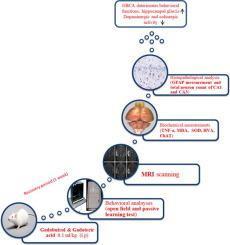Brain Research ( IF 2.9 ) Pub Date : 2021-01-07 , DOI: 10.1016/j.brainres.2020.147256 Volkan Solmaz 1 , Hatice Köse Özlece 2 , Mehmet Fatih Bozkurt 3 , Bahattin Özkul 4 , Oytun Erbaş 5

|
Gadolinium-based contrast agents (GBCAs) exert effects in different regions of the brain; however, studies on this topic are mostly focused on radiological outcomes of GBCA exposure. This paper is a preliminary attempt to identify whether there are changes in behavioral, cognitive, histopathological, radiological and biochemical characteristics with repeated exposure to gadobutrol and gadoteric acid.
The effects of GBCAs were tested with the assessment of 4 groups –each comprised of 6 rats [controls, gadobutrol, gadoteric acid (Doteram), and gadoteric acid (Clariscan)]. Respective treatments of 0.1 ml/kg were administered for 3 weeks, followed by a recovery period of 1 week without any treatment. At the end of this regimen, behavioral tests (open field and passive learning test) were performed. Additionally, histopathological analysis of the hippocampal CA1 and CA3 regions (GFAP measurement and total neuron count), biochemical measurements [TNF-a, Malondialdehyde (MDA), Superoxide dismutase (SOD), homovalinic acid (HVA) and choline acetyl transferase (ChAT) levels], and radiological findings (MRI-region of interest) were carried out in each group.
There was a significant impairment in all groups that had received gadolinium in open field and passive avoidance learning tests. Oxidative stress and inflammation markers were significantly elevated in all gadolinium groups. Additionally, increased hippocampal gliosis and decreased MRI-ROIs were observed in rats exposed to gadolinium.
Chronic gadoteric acid and gadobutrol exposure causes hippocampal gliosis and elevates oxidative stress and inflammation in rats. Radiological outcomes are also consistent with these findings. Long-term studies might be required to conclude whether gadolinium deposition in the brain causes subtle neurological deficits.
中文翻译:

反复接触钆特酸和钆布醇导致大鼠行为和记忆功能恶化:MRI、组织病理学和生化证据
钆造影剂 (GBCA) 在大脑的不同区域发挥作用;然而,关于这个主题的研究主要集中在 GBCA 暴露的放射学结果上。本文是初步尝试确定反复接触钆布醇和钆特酸是否会发生行为、认知、组织病理学、放射学和生化特征的变化。
GBCA 的作用通过对 4 组的评估进行测试——每组包括 6 只大鼠 [对照、钆布醇、钆特酸 (Doteram) 和钆特酸 (Clariscan)]。分别以0.1ml/kg的剂量给药3周,然后恢复1周,不进行任何治疗。在该方案结束时,进行行为测试(开放领域和被动学习测试)。此外,海马 CA1 和 CA3 区域的组织病理学分析(GFAP 测量和总神经元计数)、生化测量 [TNF-a、丙二醛 (MDA)、超氧化物歧化酶 (SOD)、高缬氨酸 (HVA) 和胆碱乙酰转移酶 (ChAT)水平],并在每组中进行放射学发现(感兴趣的 MRI 区域)。
在开放领域和被动回避学习测试中接受钆的所有组都有显着的障碍。所有钆组的氧化应激和炎症标志物均显着升高。此外,在暴露于钆的大鼠中观察到海马神经胶质增生增加和 MRI-ROI 降低。
慢性钆特酸和钆布醇暴露会导致海马神经胶质增生并升高大鼠的氧化应激和炎症。放射学结果也与这些发现一致。可能需要长期研究来得出结论,钆在大脑中的沉积是否会导致细微的神经功能缺损。



























 京公网安备 11010802027423号
京公网安备 11010802027423号